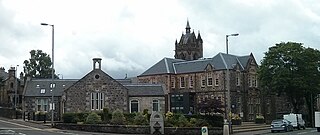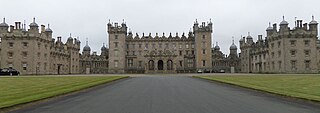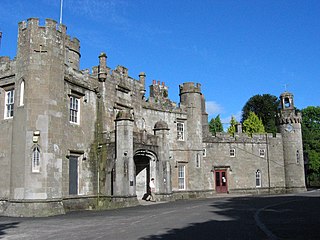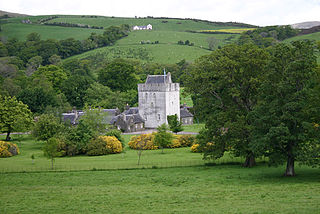
Inverclyde is one of 32 council areas used for local government in Scotland. Together with the East Renfrewshire and Renfrewshire council areas, Inverclyde forms part of the historic county of Renfrewshire, which currently exists as a registration county and lieutenancy area. Inverclyde is located in the west central Lowlands. It borders the North Ayrshire and Renfrewshire council areas, and is otherwise surrounded by the Firth of Clyde.

Gourock is a town in the Inverclyde council area and formerly a burgh of the County of Renfrew in the west of Scotland. It was a seaside resort on the East shore of the upper Firth of Clyde. Its main function today is as a residential area, extending contiguously from Greenock, with a railway terminus and ferry services across the Clyde.

Port Glasgow is the second-largest town in the Inverclyde council area of Scotland. The population according to the 1991 census for Port Glasgow was 19,426 persons and in the 2001 census was 16,617 persons. The most recent census in 2011 states that the population has declined to 15,414. It is located immediately to the east of Greenock and was previously a burgh in the county of Renfrewshire.

Methven Castle is a privately owned 17th-century house situated east of Methven, in Perth and Kinross, Scotland.

Kilmacolm is a village and civil parish in the Inverclyde council area, and the historic county of Renfrewshire in the west central Lowlands of Scotland. It lies on the northern slope of the Gryffe Valley, 7+1⁄2 miles southeast of Greenock and around 15 miles (24 km) west of the city of Glasgow. The village has a population of around 4,000 and is part of a wider civil parish which covers a large rural hinterland of 15,000 hectares containing within it the smaller settlement of Quarrier's Village, originally established as a 19th-century residential orphans' home.

Dunrobin Castle is a stately home in Sutherland, in the Highland area of Scotland, as well as the family seat of the Earl of Sutherland and the Clan Sutherland. It is located one mile north of Golspie and approximately five miles south of Brora, overlooking the Dornoch Firth.

Newark Castle is a well-preserved castle sited on the south shore of the estuary of the River Clyde in Port Glasgow, Inverclyde, Scotland, where the firth gradually narrows from the Firth of Clyde and navigation upriver is made difficult by shifting sandbanks. For centuries this location was used to offload seagoing ships, and led to the growth of Port Glasgow close to the castle on either side and to the south. When dredging techniques made the Clyde navigable as far as Glasgow the port became a shipbuilding centre, and the castle was surrounded by shipyards. Ferguson Shipbuilders, the last shipyard on the lower Clyde, stands close to the west of the castle, but the shipyards to the east were removed around the 1980s and new landscaped areas formed to the east of Newark Castle, opening up scenic views of the castle and across the Clyde from a new bypass road.

Floors Castle, in Roxburghshire, south-east Scotland, is the seat of the Duke of Roxburghe. Despite its name it is an estate house rather than a fortress. It was built in the 1720s by the architect William Adam for Duke John, possibly incorporating an earlier tower house. In the 19th century it was embellished with turrets and battlements, designed by William Playfair, for The 6th Duke of Roxburghe. Floors has the common 18th-century layout of a main block with two symmetrical service wings. Floors Castle stands by the bank of the River Tweed and overlooks the Cheviot Hills to the south.

Balloch Castle is an early 19th-century country house situated at the southern tip of Loch Lomond, in West Dunbartonshire, Scotland. Balloch was a property of the Lennox family from the 11th century, and the old castle was built in the 13th century. In the 19th century the estate was purchased by John Buchanan of Ardoch, who demolished the ruins of the old castle and erected the present building. The Tudor Gothic architecture is the work of Robert Lugar. In 1915 Balloch was bought by Glasgow City Corporation, and has been leased by West Dunbartonshire Council since 1975. The estate was designated as a country park in 1980, and since 2002 has been part of Loch Lomond and The Trossachs National Park. Although the house has been periodically used for visitor facilities and council offices, it is now included on the Buildings at Risk Register. Balloch Castle is a category A listed building, and the estate is included on the Inventory of Gardens and Designed Landscapes in Scotland.

Kames Castle is a 16th-century tower house located on the shore of Kames Bay near Port Bannatyne, on the Isle of Bute, Scotland. The castle, which is set in 20 acres (81,000 m2) of planted grounds, includes a 2-acre (8,100 m2) 18th-century walled garden. It is extended through the addition of a range of stone cottages. The castle, cottages, walled garden and other estate buildings are category B listed buildings.
The Duchal Moor Railway was a 2 ft narrow-gauge railway built in the 1920s to carry shooting parties to the grouse moors of Duchal Moor and the Muirshiel Hills, within the Clyde Muirshiel Regional Park, 3 miles (5 km) west-southwest of Kilmacolm in Scotland. It closed in the late 1970s.

Ayton Castle is located to the east of Ayton in the Scottish Borders. It is 9 kilometres (5.6 mi) north-west of Berwick-upon-Tweed, in the former county of Berwickshire. Built around a medieval tower house, the present castle dates largely from the 19th century. Ayton Castle is the caput of the feudal barony of Ayton. The castle is protected as a category A listed building, and the grounds are included in the Inventory of Gardens and Designed Landscapes in Scotland, the national listing of significant parks and gardens.

Balcarres House lies 1km north of the village of Colinsburgh, in the East Neuk of Fife, in eastern Scotland. It is centred on a mansion built in 1595 by John Lindsay (1552–1598), second son of David, 9th Earl of Crawford. The house became the family seat of the Earl of Crawford. The present house is the result of substantial extensions in the early nineteenth century, using part of a fortune made in India, but preserves much of the original mansion.

Monreith House is a category A listed Georgian mansion located 1.5 kilometres (0.93 mi) east of the village of Port William in Mochrum parish in the historical county of Wigtownshire in Dumfries and Galloway, Scotland. The classical-style house was designed by Alexander Stevens in 1791, for Sir William Maxwell, 4th Baronet. The new house replaced the now-ruined Myrton Castle on the estate which was partially dismantled to provide stone for the house. The grounds of the house are included in the Inventory of Gardens and Designed Landscapes in Scotland, the national listing of significant gardens, and are classed as "outstanding" in five out of six categories.

Ardgowan Castle, originally called Inverkip Castle, is located in the Private Garden of "Ardgowan House, Castle & Gardens" near Inverkip, Scotland. It is near the Firth of Clyde in Inverclyde, in the former county of Renfrewshire. The three-storey ruin of the 15th century tower house is protected as a category B listed building.

Ardgowan House, Castle & Gardens is a Privately owned late 18th-century mansion on the Firth of Clyde near Inverkip, Scotland. Ardgowan is located in Inverclyde, in the former county of Renfrewshire. The Ardgowan Estate has been held by the Stewart family since the early 15th century: towards the end of that century, their tower house Ardgowan Castle was built within the site of the previous Inverkip Castle fortress. The present house was erected in 1797 and completed in 1801 from designs by Cairncross. It is the seat of the Shaw Stewart baronets, currently Sir Ludovic Houston Shaw Stewart, 12th Baronet of Greenock and Blackhall.

Finlaystone House is a mansion and estate in the Inverclyde council area and historic county of Renfrewshire. It lies near the southern bank of the Firth of Clyde, beside the village of Langbank, in the west central Lowlands of Scotland.

Balmanno Castle is a moated tower house located in Perthshire hamlet of Dron, Scotland. It was built between 1570 and 1580. It is now modernised and is in good condition. The moat is still partially filled with water. It was built for George Auchinleck, after acquiring the estate. The house is a Category A listed building and the grounds are included in the Inventory of Gardens and Designed Landscapes in Scotland.

The ruins of the large courtyard style Duchal Castle lie circa 1.5 miles south-west of Kilmacolm in the Inverclyde council area and the historic county of Renfrewshire in the west central Lowlands of Scotland. The castle stands at the bottom of the valley of the River Gryfe on a peninsula created by the Blacketty and Green Waters which have their confluence beyond the two deep gorges.



















